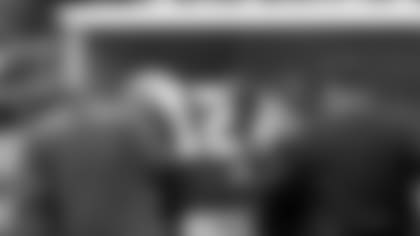Steelers inexperience shows in title game loss
Another in a series of stories chronicling the 52 playoff games in Steelers history.
It still is, almost 50 years later, the greatest touchdown play in NFL history. The Immaculate Reception combined drama, hope, controversy, euphoria, disappointment and the finality of single-elimination playoffs into a slice of life that didn't even last 30 seconds in real time but has endured for generations of football fans.
For the Pittsburgh Steelers, the Immaculate Reception was cataclysmic by definition, because this single event changed everything. It changed a perception of a team that was 40 seasons of losing in the making, and maybe more importantly, it changed the players' own perception of themselves. It validated Chuck Noll, because it was proof to the guys in the locker room that what he was teaching and the way he taught it was helping them become winners, and the Immaculate Reception energized a region that long had loved football over all other sports.
The Immaculate Reception had allowed the Steelers to win a playoff game for the first time, and the simple act of winning one playoff game jump-started a sequence of events that would turn one of the NFL's most moribund franchises into one that would come to dominate the game to an extent that rules had to be changed to try to contain it.
History will show that the Immaculate Reception was a lot of things to the Steelers franchise, but in late December 1972 more than anything it was a distraction.
Dan Rooney remembers a lot about the locker room scene following the Immaculate Reception, and the memory that still lingers is the way it was handled by Chuck Noll.
"You guys played a great game -- I'm really proud of you!" is what Noll told his team after the Steelers' 13-7 win over the Oakland Raiders on Dec. 23, 1972. "Now next week we have another big game, so don't celebrate too long."
Even amid the euphoria, Noll at his core was a coach, and because there had been no trophy presentation following the Steelers' improbable win over the Raiders that meant there still was more football to be played, more games to be won. Rooney remembers that Noll was all business even as the city exploded in celebration because Noll knew that the opponent standing between the Steelers and the AFC's berth in Super Bowl VII was the undefeated Miami Dolphins.
The next game was going to be more difficult than the last game, but all anyone wanted to talk about was the last game because of the Immaculate Reception.
Even though 1972 was a time before the internet and without talk radio and ESPN, the hype surrounding the Immaculate Reception would not die, and come the Monday before the AFC Championship Game, Noll was itching to move on but that one play continued to be big news.
In Oakland, Raiders coach John Madden continued to whine. "There was no way (the officials) were going to call it any other way with all those people on the field. Somebody would have been killed."
From Park Avenue, Jim Kensil, the Executive Director of the NFL issued the following statement about the reason for the delay before referee Fred Swearingen signaled touchdown: "(Umpire) Pat Harder has the best view of such a play. He went to Brian Burk, the back judge, and he agreed with Harder that Tatum and Fuqua both touched the ball. There was no decision from the press box, and television replay was not used in making the decision. The referee was simply clearing up a confusing situation."
But none of this put the matter to rest, and Noll was asked about it again at his first news conference of AFC championship week. "If Frenchy didn't hit the ball … and Jack Tatum didn't hit the ball …," said Noll, "well, the rule book doesn't cover the hand of the Lord."
The idea of the Pittsburgh Steelers in a conference championship game may have had the ring of fantasy-land, but it was a reality. And the Steelers had earned their spot in it. There were two wins over the Raiders, including the playoff game, and there had been confidence-establishing wins in the regular season over Minnesota and Kansas City as well. The Steelers were physical, they were tough. And they had Joe Greene.
Author Roy Blount Jr.: "When the Steelers made Greene their first pick in 1969 they laid the first and biggest building block of a six-year program that brought them up from perennial failure. That primacy is one aspect of Greene's eminence on the team; another is the assumption among the Steelers that Greene can whip any man, if not indeed every team, when he wants to."
The Steelers believed that because Greene had shown them himself, the most recent time having come just a couple of week prior, against the Oilers in Houston on Dec. 10.
The Steelers were still fighting for the division title and a spot in the playoffs – both franchise firsts – and even though there had been some big wins to their season, a loss to the 1-11 Oilers would un-do so much of that.
Winning the games it's supposed to win is a team's toughest challenge down the stretch of an NFL season, especially for a team so new to any degree of success. Even though the Oilers were finishing up a bad year, this was an important division game on the road for the Steelers, the kind of game championship teams just don't lose. But there were so many injuries …
L.C. Greenwood and Sam Davis were out. Jon Kolb and Gerry Mullins had the flu; while Kolb played, Mullins only made it into the third quarter. Bruce Van Dyke pulled a calf muscle in the first quarter and was done for the day; Jim Clack injured an ankle and was done for the day. Craig Hanneman, Greenwood's backup, aggravated a knee injury and was done for the day; Dwight White injured a knee; Steve Furness injured an ankle. Ron Shanklin was injured in the first quarter and was done for the day; Terry Bradshaw dislocated a finger in the second quarter and was done for the day; and tight end Larry Brown, who would grow into an offensive tackle, was that day playing flanker.
The Steelers needed a hero, and Joe Greene stepped up. He had five sacks and blocked a short field goal attempt by the Oilers; he recovered one fumble and forced another, and those takeaways led to two Roy Gerela field goals. The Steelers won, 9-3, and Greene was responsible for nine of the points himself – six the Steelers scored and the three the Oilers did not.
Then came a win to close the regular season and clinch the AFC Central Division followed by a victory in the AFC Divisional Round of the players, and the Steelers were in the 1972 AFC Championship Game. They were there on merit, and Chuck Noll wanted the focus to be on the Miami Dolphins, not on what had or had not happened the previous weekend against the Raiders.
These Dolphins were undefeated, and among the qualities that team possessed to allow it to be undefeated were its efficiency and its resiliency. The 1972 Miami Dolphins just didn't make mistakes, not the kind that cost a team a game – not turnovers by the offense, not big plays allowed by the defense – and it had found a way to continue to win despite losing starting quarterback Bob Griese for 10 weeks with a broken leg.
Said Steelers starting center Ray Mansfield, "Charging teams can make you look bad at times, but once in a while you can break something by them for big yardage. Miami uses a reading type of defense. They play down the line and follow the ball. It's just great team defense, and nothing comes easily against them."
In those days, the sites of the conference championship games were part of a rotation system among the three divisions and were not tied to regular season records. The AFC East had been the host in 1971, and the Dolphins played at home. In 1972, it was the AFC Central and so the game was at Three Rivers Stadium. There was snow in Pittsburgh early that week, but come the weekend the weather turned unseasonably warm for a Dec. 31 in Western Pennsylvania. Mother Nature didn't seem interested in helping the Steelers.
The Steelers responded to the enthusiasm of game day by taking a 7-0 lead, but the touchdown came with a price. Guard Gerry Mullins would recover Terry Bradshaw's fumble in the end zone for the points, but the Steelers lost their quarterback for a time to a concussion. Then to compound their problems, the Steelers' inexperience began to show.
They lost contain on a Dolphins punt, and instead of kicking the ball Larry Seiple ran 37 yards to set up the tying touchdown. The Steelers fought back to take a 10-7 lead, but then Bob Griese came off the bench to replace a struggling Earl Morrall and promptly threw a dart to a slanting Paul Warfield for 52 yards to set up a short run by Jim Kiick for a touchdown. Steelers linebacker Andy Russell took the blame for the big play. "I was supposed to close off the inside, and I simply didn't do it."
There were other mistakes, too. Dwight White jumped offside to negate a Jack Ham interception; Miami's Howard Moore blocked a Roy Gerela field goal attempt to give the Dolphins the favorable field position they needed to score the game-winning touchdown; and Bradshaw threw two interceptions once the Steelers had closed their deficit to 21-17. That would be the final score.
Said Noll, "We made too many mistakes, or maybe we didn't make enough big plays."
Added Russell, "We could've beaten them, and I think they know that. But it's one thing to have the potential to beat them and another thing to do it."
| ||||










